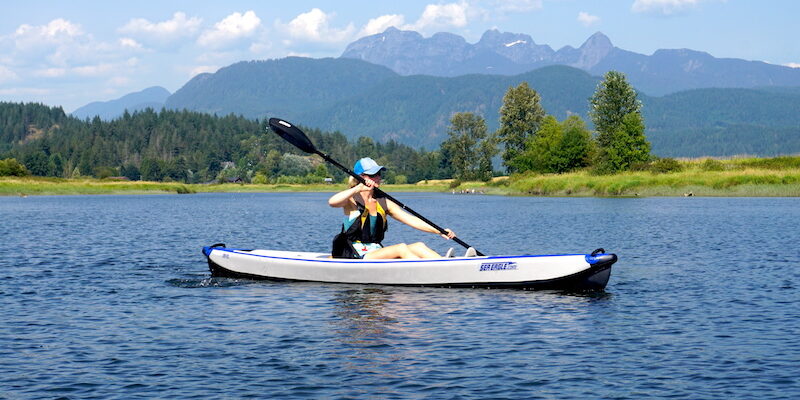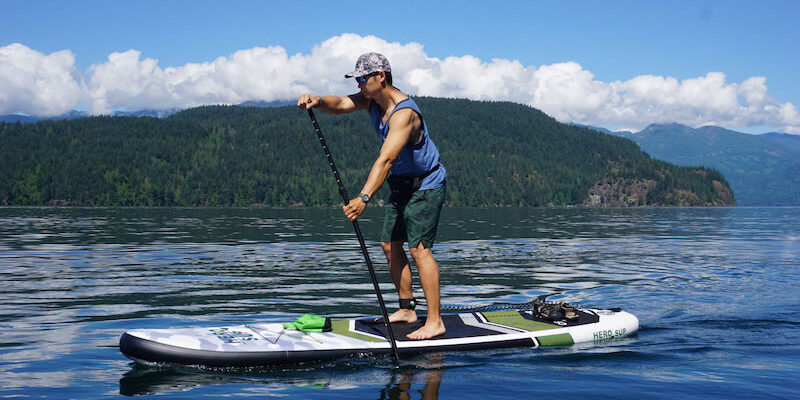This is a guest post by Sandra Roberts. Sandra is a freelance writer with a passion for being out in nature. She has been kayaking with family and friends for over 30 years.
Kayaking is a terrific pastime that can provide hours of good clean fun, having said that there can be some dangers if you do not follow a few simple rules and learn the basics.
It is important to learn just a few key points of kayaking before you ever hit the water. It is much safer that way. You do not want to set out for the first time with no paddling knowledge or you could run in to some trouble.
Kayaking is one of the world’s most popular recreational sports, it embraces the great outdoors, it is healthy, it is a challenge, it is a great way to spend a few hours or even days with like-minded friends, it can enable you to get to places which would be otherwise out of reach on your adventures.
It is great for those who like to fish or just enjoy a little peace and solitude on a shimmering lake on a sunny afternoon.
Okay that’s enough – you are probably already hooked – here is a beginners guide to kayaking so that you can safely get out on the water, enjoy yourself and paddle your own kayak or canoe as soon as possible.
The Different Types of Kayaks
All kayaks are definitely not the same. Beginner’s do not generally jump in at the deep end and expect to compete so, for the purposes of this article we will focus on recreational kayaks.
Recreational paddling usually takes place on calm waters like flat rivers and lakes. At the beginner level you will not be tackling any white water rapids or heavy surf.
Recreational paddling can be a very calm pursuit or if you are more physically fit, you can push yourself for some great exercise.
It is often teamed up with some fishing, waterfowl spotting, photography or fun with friends and family. Recreational kayaks make terrific first kayaks and are brilliant for learning in as they tend to be quite stable.
A single kayak has room for one paddler, a tandem can take two and a tri has space for three paddlers.
All recreational kayaks are typically:
- A little extra wide for a little extra stability
- Easy entry and exit due to the wider openings at the cockpits
- They do not usually measure any more than 12 feet – this makes them a little slower than the more expensive racing models
- They do not have a lot of cargo capacity which is okay because they are typically used for day trips only
Getting Into The Kayak And Out Again
The ease of getting in and out of your kayak will depend on a couple of things:
- How stable your kayak is
- If you will be entering and exiting the kayak from the beach or from a dock
Getting in from the beach is usually no big deal. Place your paddle in the kayak. Then place one foot in the cockpit while holding on to the sides of the kayak.
Then crouch low and swing your other leg in and sit quickly. Unless you have someone else there to push you off, you will probably have to step in the water a bit to get the kayak off the rocks and into deeper water.
If you are out solo, you can push yourself off with your paddle. You can also use your paddle to help balance yourself when getting in and out.
If you are getting in from a dock it can take a little more practice. Sit on the edge of the dock and dangle your legs over onto the edge of the cockpit to balance it.
Then line up your position of entry and swing one foot right into the cockpit center followed rapidly by the other foot, crouch down first then go into a sitting position (keep one hand holding onto the dock).
Next grab your paddle off the dock then put the tie line into the cockpit so that it does not end up trailing in the water. Getting out is almost exactly the same . . . except you do everything the other way around!
The Techniques of Paddling
Different paddlers use different techniques. There are a few basic strokes that are good to learn but over time many paddlers will develop their own technique that works for them.
Your individual technique will also depend upon certain physical features. Taller people are naturally further above the surface of the water and can tend to dig into the water if they are not careful.
When you first get into the kayak it is best just to relax and get a feel for the whole experience, then take it slowly and naturally.
Paddling Tips
1. Lean back into your seat. It not only keeps the paddler comfortable but also helps with the stability of the boat; all movement should be from the torso alone.
2. For your grip, your knuckles should be more or less lined up with the upward blade edge. Hold the paddle with your fingers over and your thumbs under.
3. Turning the kayak is pretty easy really; paddling on only one side of the kayak will turn it in the opposite direction.
Paddling technique is something that you should initially practice on calm flat water. After even just a couple of times out you will find that you get the hang of it very quickly.


Thanks for the post. I have kayaked about 10 times, love it. I really want to get my own boat so I can go out for short periods whenever I want, instead of renting. Can you reccomend a lightweight recreational kayak that is decent for the value?
Hi Jacquelyn,
Depending on the price range you are looking at, here are a few options to consider…
The Sea Eagle 330 or 370 are a great choice for beginners as they are light, easy to paddle and really give you a lot for your money. They are quite versatile.
The Advanced Elements Sport is good value for the money. It doesn’t track as well as the others mentioned but looks great, is comfortable and fun to paddle.
The Airis Play is another good choice. It is a little higher priced but the quality is excellent and it is extremely portable. It is fairly small and light weight. Great for traveling and easy for one person to carry.
The Innova Swing is another one I would recommend. Excellent quality, easy for one person to handle and paddles well on lakes, ocean bays or calm rivers.
Cheers.